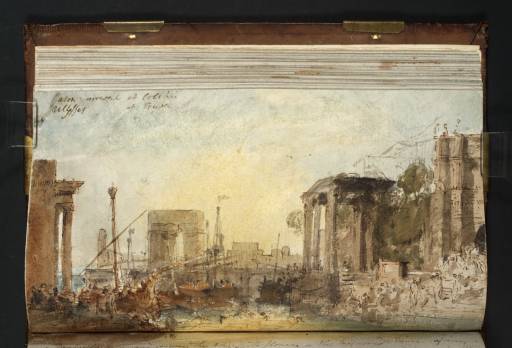Joseph Mallord William Turner A Classical Harbour 1805
Joseph Mallord William Turner,
A Classical Harbour
1805
Joseph Mallord William Turner 1775–1851
Folio 49 Verso:
A Classical Harbour 1805
D05568
Turner Bequest XC 49a
Turner Bequest XC 49a
Pen and ink and watercolour, with scratching out, on off-white wove paper, prepared with a grey wash, 150 x 258 mm
Inscribed by Turner in ink (see main catalogue entry) top left and continuing on folio 50 [D05569]
Inscribed by Turner in ink (see main catalogue entry) top left and continuing on folio 50 [D05569]
Accepted by the nation as part of the Turner Bequest 1856
Exhibition history
1974
Turner 1775–1851, Royal Academy of Arts, London, November 1974–March 1975 (94).
2000
Pure as Italian Air: Turner and Claude Lorrain, Tate Britain, London, November 2000–April 2001 (no catalogue).
2001
William Turner: Licht und Farbe, Museum Folkwang, Essen, September 2001–January 2002 (34).
2002
Turner et le Lorrain, Musée des beaux-arts, Nancy, December 2002–March 2003 (10).
References
1909
A.J. Finberg, A Complete Inventory of the Drawings of the Turner Bequest, London 1909, vol.I, p.236, XC 49a, as ‘A classical embarkation scene’.
1974
Martin Butlin, Andrew Wilton and John Gage, Turner 1775–1851, exhibition catalogue, Royal Academy of Arts, London 1974, p.59.
1987
Andrew Wilton, Turner in his Time, London 1987, pp.69–70.
1990
Kathleen Nicholson, Turner’s Classical Landscapes: Myth and Meaning, Princeton 1990, pp.69, 147, 268, 310 reproduced pl.8.
1993
David Hill, Turner on the Thames: River Journeys in the Year 1805, New Haven and London 1993, p.162.
1996
Gillian Forrester, Turner’s ‘Drawing Book’: The Liber Studiorum, exhibition catalogue, Tate Gallery, London 1996, p.136 note 6.
1997
Anthony Bailey, Standing in the Sun: A Life of J.M.W. Turner, London 1997, p.91.
2001
Andrew Wilton, Inge Bodesohn-Vogel and Helena Robinson, William Turner: Licht und Farbe, exhibition catalogue, Museum Folkwang, Essen 2001, pp.97 reproduced in colour, 288.
2002
Ian Warrell, Blandine Chavanne and Michael Kitson, Turner et le Lorrain, exhibition catalogue, Musée des beaux-arts, Nancy 2002, p.58, 59 reproduced in colour.
See note to folio 1 of the sketchbook (D05491) for its various composition studies of an ancient seaport with figures arriving or departing, and their sometimes interchangeable subjects. Ideas for this version, focused on the triumphant return of a hero or captive, are noted by Turner in his inscription beginning on this leaf, ‘Jason: arrival at Colchis | Ulysses: at Cryse’, and continuing on folio 50 (D05569), ‘Females dancing and crowning the rope [?] with flowers, in the Foreground Figures rejoicing | The left – the Priest awaiting to receive the Fleece. Jason & Argonauts on Board bearing the Fleece | Ulysses with Chryseis offering her to her Father’.
The episodes in the story of Jason and the Golden Fleece were most likely known to Turner from translations by Francis Fawkes of the Argonautics of Apollonius Rhodius. The Asian city of Colchis, home of Medea and the court of King Aetes, was the Argonauts’ destination before Jason captured the Fleece; they then returned to Iolchos, a seaport in Thessaly, where they were greeted with festivities. Turner’s inscription above the drawing sems to cite the former city while that on folio 50 must refer to the latter. An upright classical landscape composition on folio 58 verso (D05584) is labelled by Turner with alternative subjects including ‘Return of the Argo’. For Chryses and his daughter, see especially folio 34 (D05541). The reading of Turner’s final word on the present sheet as ‘Cryse’ (that is, their home city of Chryse) would fit the present subject better than ‘Euryalus’ (Ulysses’s illegitimate son), proposed by Hill, or the puzzling ‘Crusa’ given by Finberg. Moreover as Nicholson observes, the composition is similar to that on folio 34 which Turner associated with the return of Chryseis. Wilton misread Turner’s ‘Ulysses’ in the last line on folio 50 as ‘Odysseus’.1
Finberg observed in the present drawing ‘some resemblance’ to Dido Building Carthage (National Gallery, London)2 but this was probably not foreseen by Turner. More convincing is Warrell’s comparison of Turner’s design to Claude’s Seaport with the Arrival of the Queen of Sheba (National Gallery, London) which had been bought by John Julius Angerstein in 1803.3
There is some overlap of the foreground washes over the gutter of the sketchbook on to folio 50.
David Blayney Brown
August 2007
How to cite
David Blayney Brown, ‘A Classical Harbour 1805 by Joseph Mallord William Turner’, catalogue entry, August 2007, in David Blayney Brown (ed.), J.M.W. Turner: Sketchbooks, Drawings and Watercolours, Tate Research Publication, December 2012, https://www

